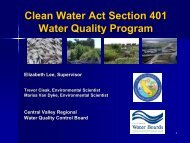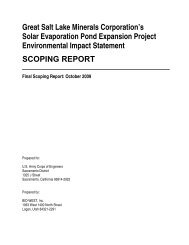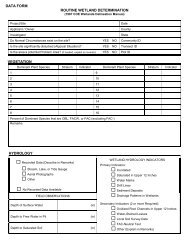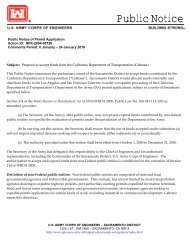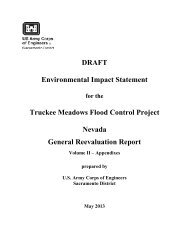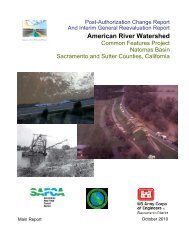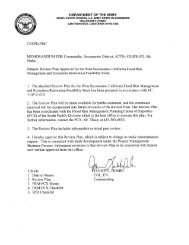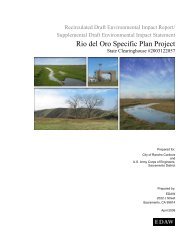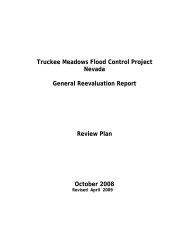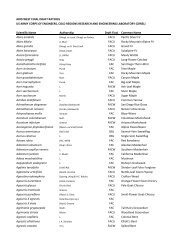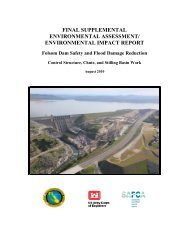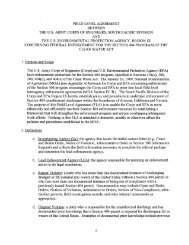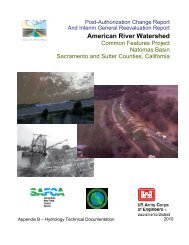Final Sacramento District Nationwide Permit Regional Conditions for ...
Final Sacramento District Nationwide Permit Regional Conditions for ...
Final Sacramento District Nationwide Permit Regional Conditions for ...
You also want an ePaper? Increase the reach of your titles
YUMPU automatically turns print PDFs into web optimized ePapers that Google loves.
that a copy of the permit authorization and associated drawings are available and visible <strong>for</strong> quick referenceat the site until all construction activities are completed.12. The permittee shall clearly identify the limits of disturbance in the field with highly visible markers(e.g. construction fencing, flagging, silt barriers, etc.) prior to commencement of construction activitieswithin waters of the U.S. The permittee shall maintain such identification properly until construction iscompleted and the soils have been stabilized. The permittee is prohibited from any activity (e.g. equipmentusage or materials storage) that impacts waters of the U.S. outside of the permit limits (as shown on thepermit drawings).13. For all activities in which a PCN is required, the permittee shall notify the appropriate district office ofthe start date <strong>for</strong> the authorized work within 10 days prior to initiation of construction activities.14. The permittee shall allow Corps representatives to inspect the authorized activity and any mitigationareas at any time deemed necessary to determine compliance with the terms and conditions of the NWPverification. The permittee will be notified in advance of an inspection.15. For all activities located in the Mather Core Recovery Area in <strong>Sacramento</strong> County, as identified in theU.S. Fish and Wildlife Service’s Recovery Plan <strong>for</strong> Vernal Pool Ecosystems of Cali<strong>for</strong>nia and SouthernOregon dated December 15, 2005, NWPs 14, 18, 23, 29, 39, 40, 42, 43 and 44 are revoked from use invernal pools that may contain habitat <strong>for</strong> Federally-listed threatened and/or endangered vernal pool species.16. For activities located in the Primary or Secondary Zone of the Legal Delta, NWPs 29 and 39 arerevoked.17. For all activities within the Secondary Zone of the Legal Delta, the permittee shall conductcompensatory mitigation <strong>for</strong> unavoidable impacts within the Secondary Zone of the Legal Delta.18. For NWP 12: <strong>Permit</strong>tees shall ensure the construction of utility lines does not result in the draining ofany water of the U.S., including wetlands. This may be accomplished through the use of clay blocks,bentonite, or other suitable material (as approved by the Corps) to seal the trench. For utility line trenches,during construction, the permittee shall remove and stockpile, separately, the top 6 – 12 inches of topsoil.Following installation of the utility line(s), the permittee shall replace the stockpiled topsoil on top and seedthe area with native vegetation. The permittee shall submit a PCN <strong>for</strong> utility line activities in the followingcircumstances:a. The utility line crossing would result in a discharge of dredged and/or fill material into perennialwaters, intermittent waters, wetlands, mudflats, vegetated shallows, riffle and pool complexes, sanctuariesand refuges or coral reefs;b. The utility line activity would result in a discharge of dredged and/or fill material into greaterthan 100 linear feet of ephemeral waters of the U.S.;c. The utility line installation would include the construction of a temporary or permanent accessroad, substation or foundation within waters of the U.S.; ord. The proposed activity would not involve the restoration of all utility line trenches to pre-projectcontours and conditions within 30 days following completion of construction activities.19. For NWP 13 and 14: All bank stabilization activities shall involve either the sole use of nativevegetation or other bioengineered design techniques (e.g. willow plantings, root wads, large woody debris,etc.), or a combination of hard-armoring (e.g. rip-rap) and native vegetation or bioengineered designPage 4 of 6* <strong>Regional</strong> Condition developed jointly between <strong>Sacramento</strong> <strong>District</strong>, Los Angeles <strong>District</strong>, and San Francisco <strong>District</strong>.



